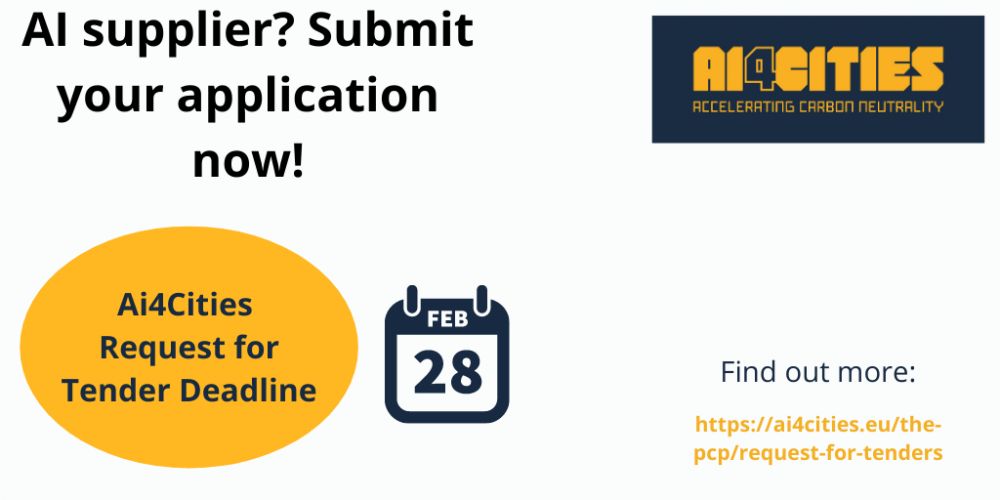Pre-application deadline FAQ
24 February 2021
Suppliers are increasingly asking Ai4Cities relevant questions about the Request for Tender, the PCP and the project in general. From now on we will provide weekly updates of the most recent questions and answers. Please see here the overview for the week of 22.02:
-Is it possible to formulate adjustment suggestions on the AI4Cities PCP framework agreement in the current tendering phase?
In open procedure type procurements, tender specifications and model contracts (e.g. the framework agreement) are not negotiable. The agreement is the basic PCP Framework Agreement model required by the EC.
-In addition to the confirmation that we have an appropriate insurance level for AI4Cities, what is the extra information that you need to know on the different kinds of insurances?
We are looking for a short clarification if there are any special risks related to the solution and if there are any insurances related to that. We are not expecting a list of all insurances you have.
-The selection criteria refer to products or services ‘suitable for production or supply in quantity and to quality standards defined by the procurers.’ Where are these quality standards of the procurers described?
These standards will be specified in Phase 3 call-off documents. In the Phase 1 the we are focused on the solution design and the idea.
-Is there any required precentage for material and equipment cost?
The most of the R&D cost should be personnel cost but you can include some materials, equipment or related cost included in R&D if it is necessary for the implementation of the solution. There is no exact percentage.
-Could you clarify the need for MaaS in Stavanger?
We are looking to potentially test Mobility as a Service (MaaS) solutions. Quite a few mobility solutions have been introduced, or will be introduced in Stavanger (and the region around). Kolumbus (the local transport authority) have included city-bikes, busses, boats/ferries and trains in one digital solution, but there is still some way to go to get the best out of all the modes of transport. A MaaS solution that includes the available modes of transport, and that makes them function as a more dynamic whole would be really interesting to test for Stavanger and Kolumbus. Public transport, which in Stavanger consists of busses, boats and a rail line, could become a much more attractive alternative to driving a car if more of the different modes of transport are bound together by a solution, and in a way that will make passengers able to dynamically plan and use the different modes in an effective way. Using different modes of transport will be a much more attractive if it is easy to plan and carry through. Where are the different means of transport? How can we easily find them? How can we use them and combine them, and how fast will we be able to travel between different places/modes of transport? What are the best routes, and what are the best routes if we need to re-plan? There are many different modes of transport in use in Stavanger. in the Data Section there is an overview from Kolumbus. In addition to this there are also private suppliers of e-scooters, car-sharing services and more.
-What is the role of district heating in Stavanger?
The major part of heating for Stavanger area is based on electric (hydrogenated) power. The district heating companies association for the Stavanger/Sandnes area (Sandnes is the neighbour city) is reporting 114 GWh for 2019, where 5% is bio and 95% recovered heat, see also Stavanger/Sandnes (Fjernkontrollen.no).
-Is it be possible that the members of the consortium submit the invoices separately?
Only the lead tenderer can submit the invoice.
-Can the different forms be signed digitally and uploaded together as one PDF? Or do you want them to signed manually and upload the scanned document?
The Forms can be signed digitally, but please upload every Form as a separate document, not together as one PDF.
Also, we do not accept scanned PDFs or other scanned documents.
-Why can we not find the labour price used for R&D, or the limit for the price per hour?
There are no pre-defined prices available, because you are making the bid and and telling us how much your project will cost. The price of your project is one of the awards criteria.
-The Virtual price will exceed the amount of €40,000 for phase 1. is that OK or should both the Virtual and the Actual price be below €40 000?
Virtual price is the market price, which means the price including IPRs, ownership of results and your profits. It depends on the product but that price can be over 40,000€.
-Are we allowed to allocate indirect costs in the financial section?
There is no indirect cost in PCP.
-Is it possible to address Germany and Switzerland courts instead of the District Court of Helsinki (on Form_A)?
Unfortunately not. We are following the law of Finland, because the lead tenderer Forum Virium Helsinki is based in Finland.
-What does the following in Form_D mean: "The Tenderer declares [...] the total value of products offered in each Phase will be less than 50 % of the total value of the framework agreement."?
The PCP is for R&D development so at least 50% of the cost must be personnel cost (=work). In this context, the 'products' means the solution and the equipment related to that. You can’t produce the solutions except for the piloting purposes.
All news
